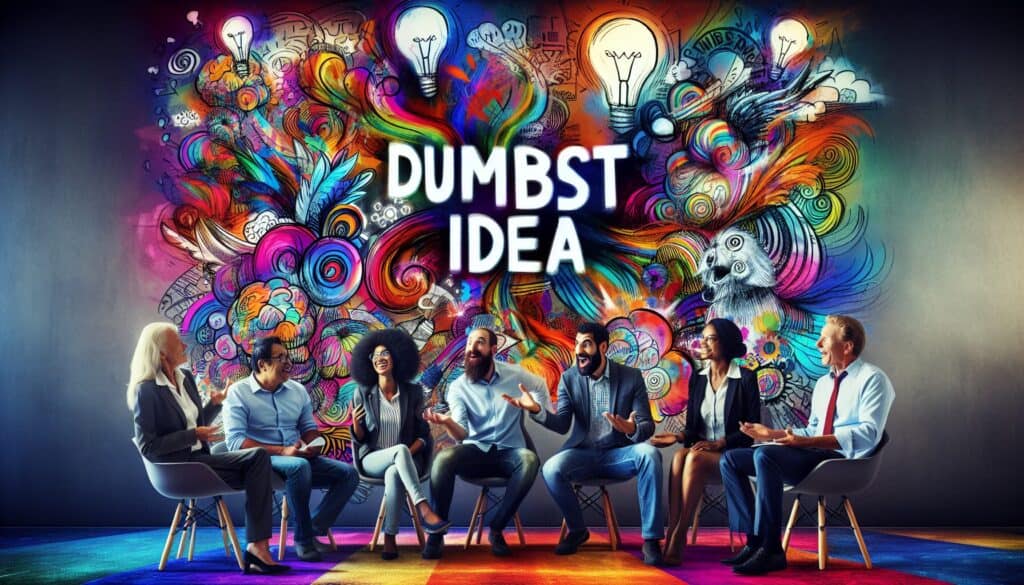A brainstorming technique where participants intentionally generate impractical, silly, or “dumb” ideas as a way to loosen up, break down creative barriers, and spark more innovative thinking.
- Méthodologies : Gestion de projet
Dumbest Idea First (Worst Possible Idea)

Dumbest Idea First (Worst Possible Idea)
- Méthodologie Agile, Remue-méninges, Amélioration continue, Créativité, Collaboration interfonctionnelle, Pensée conceptuelle, Idéation, Innovation, Techniques de résolution de problèmes
Objectif :
Comment il est utilisé :
- The group focuses on coming up with the worst or most unworkable solutions to a problem. These bad ideas can then be reversed or used as stepping stones to good ideas.
Avantages
- Reduces fear of judgment and encourages participation; can inject humor and energy into the session; bad ideas can often spark genuinely good, unconventional ideas by challenging assumptions.
Inconvénients
- May be perceived as a waste of time by some if not facilitated well; requires a shift in mindset to see the value in "bad" ideas; needs a follow-up process to transform or build upon these ideas.
Catégories :
- Idéation
Idéal pour :
- Overcoming creative blocks and fostering a more open ideation environment by starting with intentionally bad ideas.
This methodology is particularly applicable in industries such as software development, consumer electronics, and product innovation, where creative solutions are fundamental to success. During brainstorming sessions, teams can shift the focus from conventional thinking to deliberately absurd concepts, facilitating a more relaxed atmosphere that diminishes the fear of criticism. Participants typically include cross-functional team members, such as designers, engineers, marketing experts, and end-users, who bring diverse perspectives that can enhance the depth of ideation. This approach can be particularly useful in the early phases of project development, where clarifying goals and challenges is crucial. For instance, a team tasked with developing a new app might initially list out the most impractical features or functionalities, using these “worst ideas” to dissect what wouldn’t work and why, thereby illuminating viable options and promoting creative breakthroughs. This technique is often employed alongside other ideation processes, such as design thinking or agile methodologies, enriching the creative pipeline by challenging existing assumptions and pushing the boundaries of what is considered feasible. Organizations like IDEO have utilized similar tactics to invigorate their design processes, and tech companies often harness this method during innovation workshops to catalyze évolution du produit. These sessions can inject humor and energy, transforming problem-solving into an engaging and collaborative endeavor, reinforcing team dynamics while generating unexpected insights that can form the basis for robust design solutions.
Principales étapes de cette méthodologie
- Define the problem or challenge clearly.
- Encourage participants to generate the worst possible ideas without filtering.
- Document all bad ideas without judgment.
- Analyze the bad ideas for underlying assumptions and thought patterns.
- Identify elements from the bad ideas that can be reversed or improved.
- Develop new ideas by transforming the worst ideas into potential solutions.
- Evaluate the new ideas for feasibility and potential effectiveness.
Conseils de pro
- Encourage teams to adopt absurd personnes or roles; this can shift their thinking and reveal unexpected angles.
- Incorporate timed bursts of idea generation for worst ideas; time pressure can lead to more bizarre and unfiltered suggestions.
- Facilitate a “reverse pitch” where team members argue why a bad idea could work; this forces deeper analysis and can reveal hidden merits.
Lire et comparer plusieurs méthodologies, nous recommandons le
> Référentiel méthodologique étendu <
ainsi que plus de 400 autres méthodologies.
Vos commentaires sur cette méthodologie ou des informations supplémentaires sont les bienvenus sur le site web de la Commission européenne. section des commentaires ci-dessous ↓ , ainsi que toute idée ou lien en rapport avec l'ingénierie.
Contexte historique
1949
1950
1950
1960
1960
1960
1960
1940
1950
1950
1958
1960
1960
1960
1960
(si la date est inconnue ou n'est pas pertinente, par exemple "mécanique des fluides", une estimation arrondie de son émergence notable est fournie)















Articles Similaires
Questionnaires sur les troubles musculo-squelettiques
Tests à plusieurs variables (MVT)
Analyse de régression multiple
Systèmes de capture de mouvement
Méthode MoSCoW
Test de la médiane de Mood